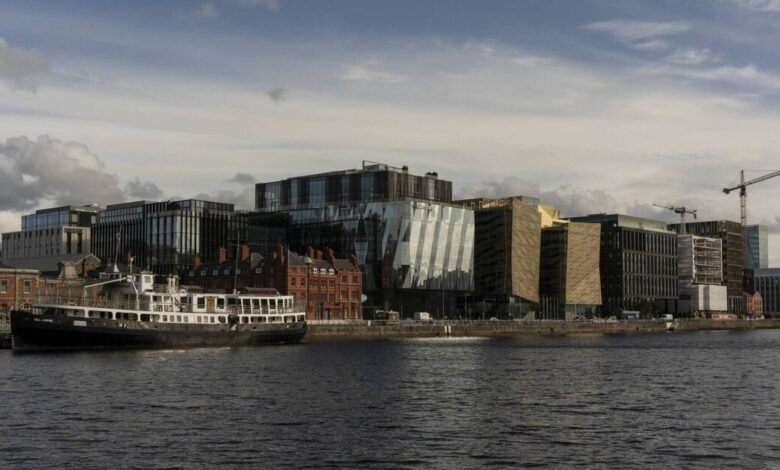A different kind of property crash is playing out in Dublin

Office landlords, battered by a global crash, have been clinging to the hope new buildings with strong green credentials will still demand top rents and prices. Dublin is emerging as a cautionary tale that such optimism may not hold up.
In the North Docks, new buildings are falling into bankruptcy protection after US tech firms scaled back the amount of new space they leased and borrowing costs rose.
Values are already down 40% to 50% from their peak, according to investors and brokers, who expect price declines and strains in financing to continue in the coming months.
The slump is playing out in the area best known a decade ago for the unfinished shell of the new headquarters for Anglo Irish Bank after its demise helped tank the economy during the financial crisis.
Ireland’s subsequent rebound was driven in part by the expansion of firms such as Alphabet and Meta. That boosted demand for workspace, and developers rushed to provide it, until Big Tech’s expansion halted amid a focus on costs after a hiring binge during the pandemic.
“The tech sector has more of a remote working culture than many other industries, which seems to have become even more entrenched owing to the pandemic,” said Sue Munden, a senior research analyst at Bloomberg Intelligence.
“Tech clusters such as Dublin may be more vulnerable to any pull-backs in space demand by the industry.”
Dublin’s docklands have been radically altered in recent years, with an economically deprived quarter of the city transformed into a business and residential neighbourhood. But there has been a growing number of troubled properties in the North Docks part of the area in recent months.
A building leased to Meta in the area was seized by a creditor last year, while veteran developer Johnny Ronan saw a number of assets, including an office block there, enter a consensual restructuring process in late 2023. Mr Ronan declined to comment.

Since then, Pacific Investment Management Co appointed receivers to a North Docks project developed by a venture that includes Nama. The buildings may sell for less than the value of the €120m senior debt provided by Pimco, according to two brokers with knowledge of the matter. Nama and Pimco declined to comment.
It is part of a wider global downturn that has hit commercial real estate valuations from New York to London and Hong Kong, with implications for developers, investors, banks and other lenders.
More commercial real estate loans will run into trouble this year as office tenants cut space, according to Fitch Ratings, making refinancing harder and leaving older buildings at risk of being left empty.
In Dublin, office leasing in the first quarter fell to a decade low, excluding the pandemic, according to Jones Lang LaSalle. Central Bank governor Gabriel Makhlouf said earlier this year regulators were “keeping a very close eye” on commercial real estate but “at the moment we feel that the system is resilient enough to manage the falling valuations”.
One reason for optimism is that the downturn will not hit Irish banks anywhere near as hard as in 2008. Instead, much of the financing this time around was provided by private credit firms.
In the Irish capital as in other places, landlords and lenders have been caught out by the prevalence of work-from-home among tech workers in the aftermath of the pandemic.
Tech firms agreed to rent almost 90% less space in the fourth quarter of last year compared with the first quarter of 2019, according to data compiled by broker Lisney. Many of the buildings were leased before completion, known as pre-letting.
“With Big Tech effectively now gone from the pre-letting market, the most active demand from occupiers is from small and medium enterprises who typically take space for 20 to 80 people compared with several hundred for larger tech lettings,” said James Mulhall, managing director of broker Murphy Mulhall.
“This, combined with hybrid working models, means it will take longer to fill up office buildings.”
The Central Bank, which eventually redeveloped the Anglo Irish building as its own headquarters, is seeking to sublease about 105,000sq ft of offices at one property and is also selling some space in the area, a spokesman said.
AIB’s base case is for commercial property prices to fall 2.5% this year. Bank of Ireland sees a much deeper decline of 11%.
AIB already took what it described as a “large charge” of €327m last year, a chunk of it linked to offices. The lender believes the bulk of the downturn has taken place, a spokesperson for AIB said, and there may a modest recovery from 2025 if monetary policy is loosened later this year.
Real estate experts say it will be at least two years before the market sees an upswing, but with new construction drying up, future demand will benefit owners of the best buildings with green credentials, especially ahead of the target to slash carbon dioxide emissions by the end of the decade.
“In the medium term, there will be demand, but it will just be smaller lot sizes to cater to the new normal,” said Aoife Brennan, a senior director at Lisney.
“ESG promises will also play into it, so the demand will be for top quality, energy efficient buildings.”
Source link





